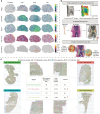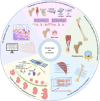Advances in spatial transcriptomics and its application in the musculoskeletal system
- PMID: 40379648
- PMCID: PMC12084619
- DOI: 10.1038/s41413-025-00429-w
Advances in spatial transcriptomics and its application in the musculoskeletal system
Abstract
While bulk RNA sequencing and single-cell RNA sequencing have shed light on cellular heterogeneity and potential molecular mechanisms in the musculoskeletal system in both physiological and various pathological states, the spatial localization of cells and molecules and intercellular interactions within the tissue context require further elucidation. Spatial transcriptomics has revolutionized biological research by simultaneously capturing gene expression profiles and in situ spatial information of tissues, gradually finding applications in musculoskeletal research. This review provides a summary of recent advances in spatial transcriptomics and its application to the musculoskeletal system. The classification and characteristics of data acquisition techniques in spatial transcriptomics are briefly outlined, with an emphasis on widely-adopted representative technologies and the latest technological breakthroughs, accompanied by a concise workflow for incorporating spatial transcriptomics into musculoskeletal system research. The role of spatial transcriptomics in revealing physiological mechanisms of the musculoskeletal system, particularly during developmental processes, is thoroughly summarized. Furthermore, recent discoveries and achievements of this emerging omics tool in addressing inflammatory, traumatic, degenerative, and tumorous diseases of the musculoskeletal system are compiled. Finally, challenges and potential future directions for spatial transcriptomics, both as a field and in its applications in the musculoskeletal system, are discussed.
© 2025. The Author(s).
Conflict of interest statement
Competing interests: The authors declare no competing interest.
Figures




Similar articles
-
Advances in spatial transcriptomics and related data analysis strategies.J Transl Med. 2023 May 18;21(1):330. doi: 10.1186/s12967-023-04150-2. J Transl Med. 2023. PMID: 37202762 Free PMC article. Review.
-
Current cutting-edge omics techniques on musculoskeletal tissues and diseases.Bone Res. 2025 Jun 9;13(1):59. doi: 10.1038/s41413-025-00442-z. Bone Res. 2025. PMID: 40484858 Free PMC article. Review.
-
Advances in single-cell sequencing and its application to musculoskeletal system research.Cell Prolif. 2022 Jan;55(1):e13161. doi: 10.1111/cpr.13161. Epub 2021 Dec 9. Cell Prolif. 2022. PMID: 34888976 Free PMC article. Review.
-
Spatial Transcriptomics: Emerging Technologies in Tissue Gene Expression Profiling.Anal Chem. 2023 Oct 24;95(42):15450-15460. doi: 10.1021/acs.analchem.3c02029. Epub 2023 Oct 10. Anal Chem. 2023. PMID: 37814884 Free PMC article. Review.
-
Spatial transcriptomics: recent developments and insights in respiratory research.Mil Med Res. 2023 Aug 17;10(1):38. doi: 10.1186/s40779-023-00471-x. Mil Med Res. 2023. PMID: 37592342 Free PMC article. Review.
Cited by
-
Applications of Spatial Transcriptomics in Veterinary Medicine: A Scoping Review of Research, Diagnostics, and Treatment Strategies.Int J Mol Sci. 2025 Jun 26;26(13):6163. doi: 10.3390/ijms26136163. Int J Mol Sci. 2025. PMID: 40649940 Free PMC article.
References
Publication types
MeSH terms
LinkOut - more resources
Full Text Sources

